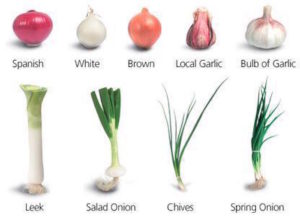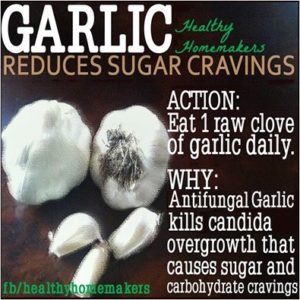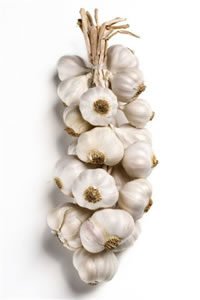
Garlic is planted in the fall and tolerates some shade but prefers full sun. It responds best in well-drained, rich, loamy soil amended with lots of organic matter. Raised beds are ideal, except in very dry regions.
Plant the cloves, the sections of the bulb; each clove will produce a new bulb. The largest cloves generally yield the biggest bulbs. To get cloves off to a strong start and protect them from fungal diseases, soak them in a jar of water containing one heaping tablespoon of baking soda and a tablespoon of liquid seaweed for a few hours before planting. Plant garlic in the fall.
Place cloves in a hole with the pointed end up, with each tip 2 inches beneath the soil. Set about 6 to 8 inches apart. Top the soil with 6 inches of mulch. Leave the mulch in place into spring to conserves moisture and suppresses weeds (garlic competes poorly with weeds).
Garlic needs about an inch of water each week during spring growth. If you augment rainfall with the garden hose, stop watering by June 1 or when the leaves begin to yellow in order to let the bulbs firm up.
By mid-June garlic will begin sprouting flowery tops that straighten out into long spiky tendrils. These savory stalks, known as scapes, should be removed to encourage more efficient bulb growth. Before adding scapes to the compost pile, try incorporating their mild garlic flavor into a delicious scape pesto, scape dip, or scape soup.
Start foliar-feeding your garlic every two weeks as soon as leaf growth begins in spring (typically March) and continue until around May 15. Use 1 tablespoon of liquid seaweed mix and 1 tablespoon fish emulsion mixed into a gallon of water.
When half to three-quarters of the leaves turn yellow-brown, it’s harvest time. Carefully dig up each bulb.
Tie garlic together in bundles of 6 to 10 bulbs and hang them to cure for about four to six weeks in a shaded, dry, and drafty area.
When thoroughly dry, trim the roots, taking care not to knock off the outer skin. Cut off the stalks about 1½ inches above the bulb if you plan to keep the garlic in bags. Recycled mesh onion bags are perfect for storage.
A whole head of garlic a day does miracles for your body. It stimulates the immune system and normalizes your gut flora. Garlic is a powerful natural antibiotic and kills a large number of different bacteria. Eating garlic on an empty stomach is effective in preventing and treating many diseases. When you consume garlic on an empty stomach increases its power as an antibiotic.







